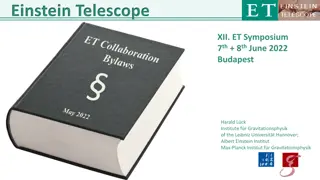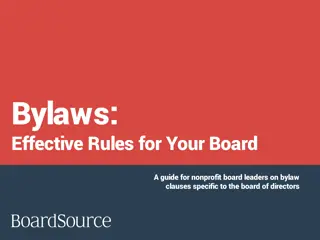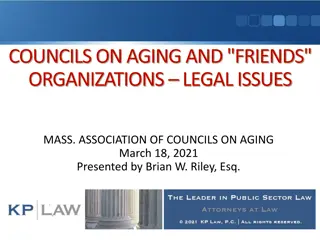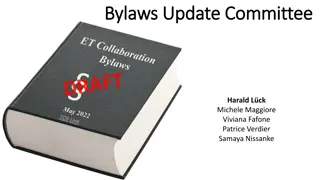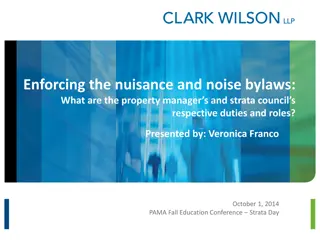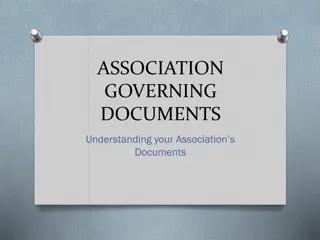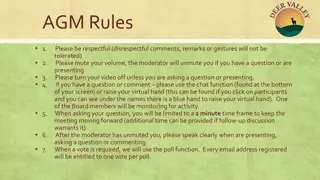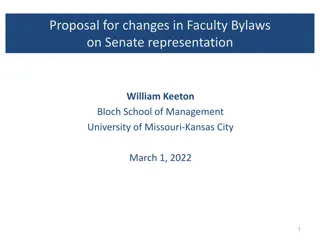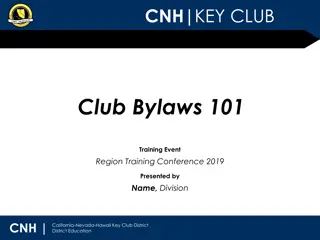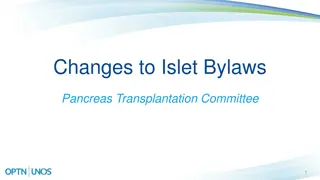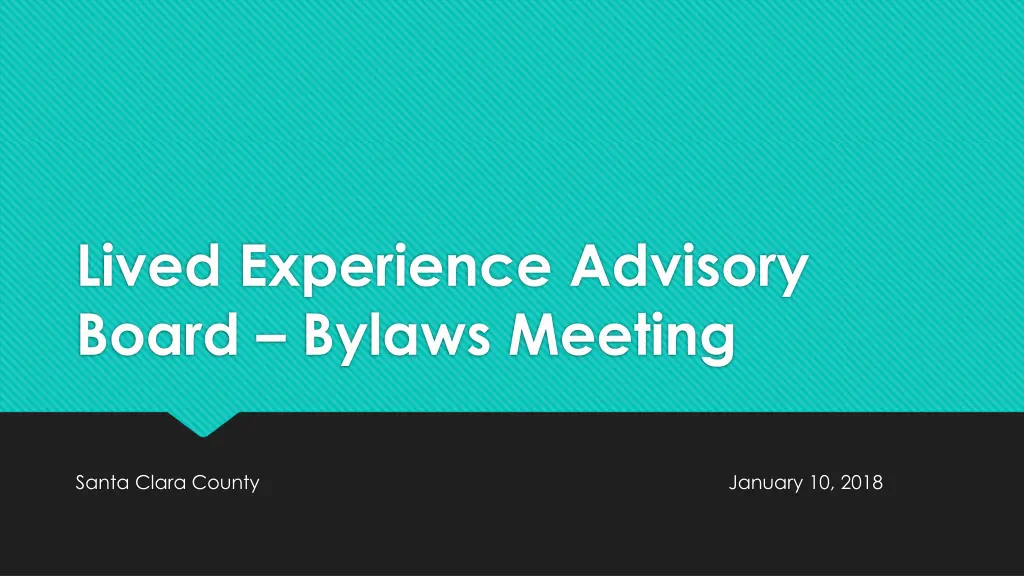
Understanding Lived Experience Advisory Board Bylaws and Membership Decisions
Gain insights into the bylaws and membership decisions of the Lived Experience Advisory Board in Santa Clara County. Learn about the purpose of bylaws, membership options, diversity mechanisms, and maintaining membership through attendance-based criteria.
Download Presentation

Please find below an Image/Link to download the presentation.
The content on the website is provided AS IS for your information and personal use only. It may not be sold, licensed, or shared on other websites without obtaining consent from the author. If you encounter any issues during the download, it is possible that the publisher has removed the file from their server.
You are allowed to download the files provided on this website for personal or commercial use, subject to the condition that they are used lawfully. All files are the property of their respective owners.
The content on the website is provided AS IS for your information and personal use only. It may not be sold, licensed, or shared on other websites without obtaining consent from the author.
E N D
Presentation Transcript
Lived Experience Advisory Board Bylaws Meeting Santa Clara County January 10, 2018
Why Bylaws? The purpose of the bylaws is to describe how the LEAB functions. Bylaws outline the LEAB s purpose and operations, who may participate, and expectations of members and leaders.
Todays Decisions Simple majority vote? Topics for Today: Membership Leadership Decision Making Agreements Subcommittee Structure
MEMBERSHIP NUMBER OF MEMBERS Need enough people to bring diverse opinions and be inclusive, but not so many as to make it hard to get things done.
MEMBERSHIP OPTIONS: 7-10 NUMBER OF MEMBERS 11-14 15-18 Other options? Need enough people to bring diverse opinions and be inclusive, but not so many as to make it hard to get things done.
MEMBERSHIP DIVERSITY MECHANISM May ensure that group has members from particular lived experiences. Upside is ideally maximizing diversity of voices, but downside is might need to keep seat open or seek out certain people for open spot.
OPTIONS: MEMBERSHIP Open policy: Find out groups with which person identifies in membership application form. Use those to attempt to bring out new groups and create diverse group. DIVERSITY MECHANISM Categories: Reserve spot on Board for, e.g., person who identifies as LGB, person who identifies as transgender, person who identifies as parenting, etc. Could do half of member seats for designated groups. May ensure that group has members from particular lived experiences. Upside is ideally maximizing diversity of voices, but downside is might need to keep seat open or seek out certain people for open spot. Other options?
MEMBERSHIP MAINTAINING MEMBERSHIP Need to ensure that those who are members are participating in the group, and if they are not, someone else might use their spot.
OPTIONS: Attendance-based For example, Members must attend at least half of meetings in a six-month period to stay in good standing. If a member attends fewer meetings, then other members may vote to remove the member from the Board. Removed member may reapply for membership at any time; this does not bar them in the future, but creates space for others who may wish to join as active participants. Action-based For example, members may bring the matter to a meeting for discussion and vote if member not contributing. If agreement to remove that member from the Board, they will be removed. Time Limit For example, a member is automatically retired after 3 continuous years as a LEAB member. Other options? MEMBERSHIP MAINTAINING MEMBERSHIP Need to ensure that those who are members are participating in the group, and if they are not, someone else might use their spot.
MEMBERSHIP MEMBER WITHOUT LIVED EXPERIENCE Sometimes in groups like the LEAB, someone who holds a related position will be a member of the group. This can open lines of communication, enhance collaboration, and bring system perspective into conversations; but it can also reduce candor, and move away from complete ownership by those with lived experience.
OPTIONS: MEMBERSHIP Invite someone from Continuum of Care (community homelessness stakeholder group) to be a non-voting member of LEAB MEMBER WITHOUT LIVED EXPERIENCE Invite someone from Continuum of Care to be a voting member of LEAB Invite someone from Continuum of Care to attend LEAB meetings to serve as liaison with CoC, without making them a full member of the Board Sometimes in groups like the LEAB, someone who holds a related position will be a member of the group. This can open lines of communication, enhance collaboration, and bring system perspective into conversations; but it can also reduce candor, and move away from complete ownership by those with lived experience. Other options?
MEMBERSHIP MEMBER MEETINGS Need to establish a schedule for members to plan ahead and for new members to know whether they are able to participate.
Frequency: Twice a Week Weekly Every other Week Monthly Other options? MEMBERSHIP MEMBER MEETINGS Length: 1 hour 2 hours 3 hours 4 hours Other options? Need to establish a schedule for members to plan ahead and for new members to know whether they are able to participate. Day/Time: Day of the Week? Time?
LEADERSHIP GROUP LEADER(S) With an advocacy group made up of many people, it can help keep the work organized to have designated person(s) who understand the mission of the LEAB and have authority to speak on behalf of the LEAB.
LEADERSHIP OPTIONS: One Chair or President of LEAB more streamlined leadership, but more rests on one person. GROUP LEADER(S) Two co-chairs or co-presidents of LEAB diffuses responsibility and tasks, increased coordination required. Other options? With an advocacy group made up of many people, it can help keep the work organized to have designated person(s) who understand the mission of the LEAB and have authority to speak on behalf of the LEAB.
LEADERSHIP SUPPORTING ROLES Note that other roles can have specific tasks to ensure that everything gets done and the work is distributed amongst several people.
OPTIONS: LEADERSHIP Chair/similar opens the meetings; sets the direction Secretary Takes minutes and emails them to the group after each meeting. May create agendas for meetings, informed by chairperson(s). SUPPORTING ROLES Liaison may have official spokesperson as voice to CoC. This person can attend CoC meetings and relay information. Note that other roles can have specific tasks to ensure that everything gets done and the work is distributed amongst several people. Other options?
LEADERSHIP LENGTH OF TENURE Create some turnover so that different people can fill different roles over time.
OPTIONS: (Co)-Chair: 2 year term 1 year term Other options? Option: If co-chairs, offset tenures such that they expire at different times. For example, After one co- chair position changes hands, the other co-chair may stay an additional 6 months regardless of time of tenure; this person may still be removed by membership by vote. LEADERSHIP LENGTH OF TENURE Other Roles: 2 year term 1 year term Other options? Create some turnover so that different people can fill different roles over time.
LEADERSHIP CHOOSING NEW LEADERS Need known approach to filling vacancies, whether because person leaves or tenure expires.
OPTIONS: LEADERSHIP By nomination For example, Any member can nominate a current member for any vacant or soon-to-vacant leadership position. If one person is nominated for the position, majority vote in favor of that person puts them in the position. If more than one person is nominated for a single position, then whichever nominee receives more votes will be put in the position. CHOOSING NEW LEADERS From another position such as Secretary Other options? Need known approach to filling vacancies, whether because person leaves or tenure expires.
DECISION MAKING QUORUM This describes the number of members who need to be present for decisions to be made. If quorum is too small, then very few members might bind the whole group to some decision; if quorum is too big, then it can be difficult to have enough members present to decide anything.
OPTIONS FOR VOTING: Quorum for voting is at least 2/3 of current members. (e.g., if the LEAB has 9 spaces filled, then 6 or more members present at a meeting make quorum.) Quorum for voting is at least half of current members. (e.g., if the LEAB has 9 spaces filled, then 5 or more members present at a meeting make quorum.) Quorum for voting is at least 1/3 of current members. (e.g., if the LEAB has 9 spaces filled, then 3 or more members present at a meeting make quorum.) Other options? DECISION MAKING QUORUM OPTIONS FOR MEETING: Quorum for holding a meeting is at least 1/3 of current members. (e.g., if the LEAB has 9 spaces filled, then 3 or more members present at a meeting make quorum.) Quorum for holding a meeting is at least 2 current members. (e.g., regardless of LEAB size, 2 members showing up for a meeting may hold the meeting, though they cannot make decisions that bind the group.) Other options? This describes the number of members who need to be present for decisions to be made. If quorum is too small, then very few members might bind the whole group to some decision; if quorum is too big, then it can be difficult to have enough members present to decide anything.
DECISION MAKING MOTIONS & VOTING For actions to be taken and decisions to be made, the group needs some way to come to agreement. A simple voting method can make decision- making as easy as possible.
Roberts Rules of Order is a standard way that many groups conduct decision-making. For any matter: (1) One member states their desired outcome by making a motion, saying I move that... (2) Another member who agrees can second the motion, saying I second the motion. If no one seconds the motion, it s not lost forever, but no vote is taken at that time. DECISION MAKING (3) If the motion is seconded, the leader of the meeting brings the group to discussion, saying It has been moved and seconded that Is there any discussion? MOTIONS & VOTING (4) During discussion, the person who made the motion may speak first. Everyone else is then able to speak as well. Ideally the leader alternates between speakers who are for and speakers against the motion. (5) Voting takes place when the leader puts the question, saying Those in favor of the motion that say Aye . Those opposed say No . Then the votes are counted, and the leader announces either The motion is carried if it passed, or The motion is lost if it did not pass. For actions to be taken and decisions to be made, the group needs some way to come to agreement. A simple voting method can make decision- making as easy as possible. Note that majority vote is over half of those entitled to vote; thus a tie vote is lost, because it is not a majority Other options?
DECISION MAKING SUBCOMMITTEE STRUCTURE Sometimes all members of the LEAB won t want, or won t be needed to, work on a particular issue. Smaller groups can be deputized to work independently with the consent of the LEAB.
DECISION MAKING At any meeting, members may vote by majority to establish a subcommittee on any topic that will further the work of the LEAB. SUBCOMMITTEE BREAK OUT GROUPS Other options? Sometimes all members of the LEAB won t want, or won t be needed to, work on a particular issue. Smaller groups can be deputized to work independently with the consent of the LEAB.
AGREEMENTS AGREEMENTS Many consumer groups have some type of Code of Conduct, Member Responsibilities, or Agreements to outline what effective membership looks like. This can communicate with current and potential members about what the expectations are for the group. These may be in the bylaws or may be a stand-alone document.
Examples: LEAB members maintain focus on representing the interests of all people with lived experience of homelessness in Santa Clara County. AGREEMENTS Members work together to establish annual goals for the group and contribute to achieving those goals. AGREEMENTS Members maintain a culture of respect and active participation. Many consumer groups have some type of Code of Conduct, Member Responsibilities, or Agreements to outline what effective membership looks like. This can communicate with current and potential members about what the expectations are for the group. These may be in the bylaws or may be a stand-alone document . Members will not use their LEAB position for personal advantage. What else?
MISSION SUGGESTION: The Lived Experience Advisory Board is a self-led body consisting of membership with lived experience of homelessness. The Board works to advocate for those who utilize the homelessness system of care through policy, planning, recommendations, and feedback to decision- makers, while supporting each other to develop professionally. GROUP PURPOSE A statement in the beginning of by- laws to focus the group s reason for existence. This is meant to summarize the overall goal of the group to explain it to others. Think of how you want a person referencing the LEAB: that group that does . Other options?
Todays Decisions and Up Next Topics for Today: Membership Leadership Decision Making Agreements How did we do? What s next? What s still missing?



